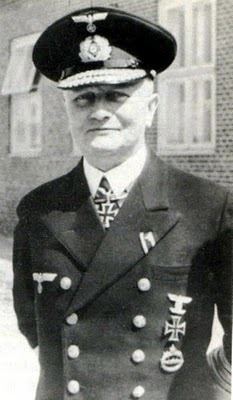Years of service 1901–45 Name Alfred Saalwachter | Rank General Admiral | |
 | ||
Born 10 January 1883
Neusalz an der Oder ( 1883-01-10 ) Died 6 December 1945(1945-12-06) (aged 62)
Moscow Allegiance German Empire (to 1918)
Weimar Republic (to 1933)
Nazi Germany Service/branch Kaiserliche Marine
Reichsmarine
Kriegsmarine Unit Moltke
Hertha
Hessen
Friedrich der Grosse
Braunschweig
Gneisenau | ||
Alfred Saalwachter (10 January 1883 – 6 December 1945) was a German U-boat commander during World War I and General Admiral during World War II.
Contents
Early life
Saalwachter was born in Neusalz an der Oder, Prussian Silesia, as the son of a factory manager. He entered the Kaiserliche Marine as a Seekadett on 10 April 1901, and was trained on SMS Moltke and Hertha. On 29 September 1904 he was promoted to Leutnant zur See.
Saalwachter then served with Bordkommando units, first with the 2. Matrosen-Division, then on Hessen with the 2. Werft-Division. He was promoted to Oberleutnant zur See on 10 March 1906; until 1908, he served with the 2. Torpedo-Division as adjutant to the I. Abteilung. Saalwachter also served on Gneisenau.
Saalwachter served on Hannover in 1910 and later on Westfalen as Flaggleutnant to Vice Admiral Hugo von Pohl, commander of the I. Marine-Geschwader. Saalwachter was promoted to Kapitanleutnant on 10 April 1911 and joined the admiralty in Berlin. He remained in the admiralty until 1915, with his last position there being head of the operations department. In 1912 he received the Order of the Red Eagle.
World War I
On 31 March 1915 during World War I, Saalwachter became Flaggleutnant on Friedrich der Grosse, the flagship of the High Seas Fleet. In February 1916 he entered the U-boat service. After graduating from submarine school, he commanded U-25, U-46, and U-94 from September 1916 to March 1918. He was awarded for his success with the Iron Cross 1st Class and the Knight's Cross of the House Order of Hohenzollern.
Interwar era
In 1920 Saalwachter was named a Korvettenkapitan of the Reichsmarine. He also served on Braunschweig as an admiralty officer. On 1 October 1926 he became commander of the light cruiser Amazone, and, a year later, Fregattenkapitan in command of the battleship Schlesien. Promoted to Kapitan zur See on 15 October 1928, Saalwachter was chief of staff for Vice Admiral Iwan Oldekop for two years. On 1 October 1932 he became a Konteradmiral and head of the Marinewehrabteilung.
On 2 October 1933 Saalwachter was named inspector for naval instruction. During the following five years he had a strong influence on the development of the young officer corps. He was promoted to Vizeadmiral on 1 April 1935 and Admiral on 1 June 1937. Saalwachter was named commanding admiral of the North Sea naval station at Wilhelmshaven, one of the highest positions in the Kriegsmarine at the time, on 28 October 1938.
On 2 March 1939, Saalwachter sent a report to the Naval High Command in which he openly discussed the acquisition of bases in Norway. The report stressed both the dangers of to Germany of British dominance in Norwegian waters and the favourable change in the geo-strategic position that a German occupation of Norway would bring about.
World War II
With the outbreak of World War II in September 1939, Saalwachter received command of Marine-Gruppenkommando West and was responsible for operations in the North Sea, which led to disputes between himself and the fleet commanders, Vice Admirals Hermann Boehm, Wilhelm Marschall, and Gunther Lutjens.
On 1 January 1940 Saalwachter was promoted to Generaladmiral. Along with Admiral Rolf Carls, Saalwachter had tactical command of Operation Weserubung, the invasion of Norway. He was recognized with the Knight's Cross of the Iron Cross on 9 May 1940. Beginning in summer 1940, Saalwachter led German surface operations in the North Atlantic and the English Channel. In 1940, he directed E-Boat forces against British shipping during the Kanalkampf phase of the Battle of Britain in support of the Luftwaffe. Later, he oversaw naval movements such as Operation Cerberus in February 1942. On 20 September of that year, he was replaced as head of Navy Group West by Marschall, who was himself replaced by Theodor Krancke in April 1943. Saalwachter resigned from active service on 30 November 1942.
Saalwachter was imprisoned by the Soviet Union on June 21, 1945. He was convicted by a Soviet military tribunal of war crimes on 17 October and executed by firing squad in Moscow on 6 December. In 1994, after the dissolution of the Soviet Union, Saalwachter was formally exonerated by a Russian court.
